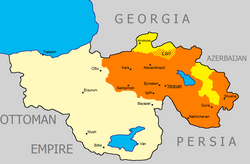First Armenian Republic
| Republic of Armenia | ||||||||||||||
| Հայաստանի Հանրապետութիւն | ||||||||||||||
|
||||||||||||||
|
Anthem Mer Hayrenik |
||||||||||||||
|
Territory held by Armenia and the Karabakh Council at some point
Territories of Armenia Occupied by Neighboring States
Area given to Armenia by the Treaty of Sèvres, which was not ratified and never entered into force.
|
||||||||||||||
| Capital | Yerevan | |||||||||||||
| Languages | Armenian | |||||||||||||
| Religion | Armenian Apostolic | |||||||||||||
| Government | Parliamentary republic | |||||||||||||
| Prime Minister | ||||||||||||||
| • | Jun 1918–May 1919 | Hovhannes Kajaznuni | ||||||||||||
| • | May 1919–May 1920 | Alexander Khatisian | ||||||||||||
| • | May–Nov 1920 | Hamo Ohanjanyan | ||||||||||||
| • | Nov–Dec 1920 | Simon Vratsian | ||||||||||||
| Historical era | Interwar period | |||||||||||||
| • | Declaration of Independence | May 28, 1918 | ||||||||||||
| • | Act of United Armenia | May 28, 1919 | ||||||||||||
| • | Sovietization | December 2, 1920 | ||||||||||||
| Area | ||||||||||||||
| • | mid-1918 (after the Treaty of Batum) | 11,000 km2 (4,200 sq mi) | ||||||||||||
| • | 1919 (after the Armistice of Mudros) | 70,000 km2 (27,000 sq mi) | ||||||||||||
| • | 1920 (per the Treaty of Sèvres; never realized) | 160,000 km2 (62,000 sq mi) | ||||||||||||
| Population | ||||||||||||||
| • | mid-1918 (after the Treaty of Batum) est. | 500,000 | ||||||||||||
| Density | 45/km2 (118/sq mi) | |||||||||||||
| • | 1919 (after the Armistice of Mudros) est. | 1,300,000 | ||||||||||||
| Density | 19/km2 (48/sq mi) | |||||||||||||
| Currency | Armenian ruble | |||||||||||||
|
||||||||||||||
The First Republic of Armenia, officially known at the time of its existence as the Republic of Armenia (classical Armenian: Հայաստանի Հանրապետութիւն), was the first modern Armenian state since the loss of Armenian statehood in the Middle Ages.
The republic was established in the Armenian-populated territories of the disintegrated Russian Empire, known as Eastern Armenia or Russian Armenia. The leaders of the government came mostly from the Armenian Revolutionary Federation (ARF or Dashnaktsutyun). The First Republic of Armenia bordered the Democratic Republic of Georgia to the north, the Ottoman Empire to the west, Persia to the south, and the Azerbaijan Democratic Republic to the east. It had a total land area of roughly 70,000 km² (174,000 km² under the Treaty of Sèvres), and a population of 1.3 million.
The Armenian National Council declared the independence of Armenia on 28 May 1918. From the very onset, Armenia was plagued with a variety of domestic and foreign problems. A humanitarian crisis emerged from the aftermath of the Armenian Genocide as tens of thousands of Armenian refugees from the Ottoman Empire settled there. The republic lasted for over two years, during which time it was involved in several armed conflicts caused by territorial disputes. By late 1920, the nation was conquered by the Soviet Red Army. The First Republic, along with the Republic of Mountainous Armenia which repelled the Soviet invasion until July 1921, ceased to exist as an independent state, superseded by the Armenian Soviet Socialist Republic that became part of the Soviet Union in 1922. After the fall of the Soviet Union, the republic regained its independence as the current Republic of Armenia in 1991.
...
Wikipedia



